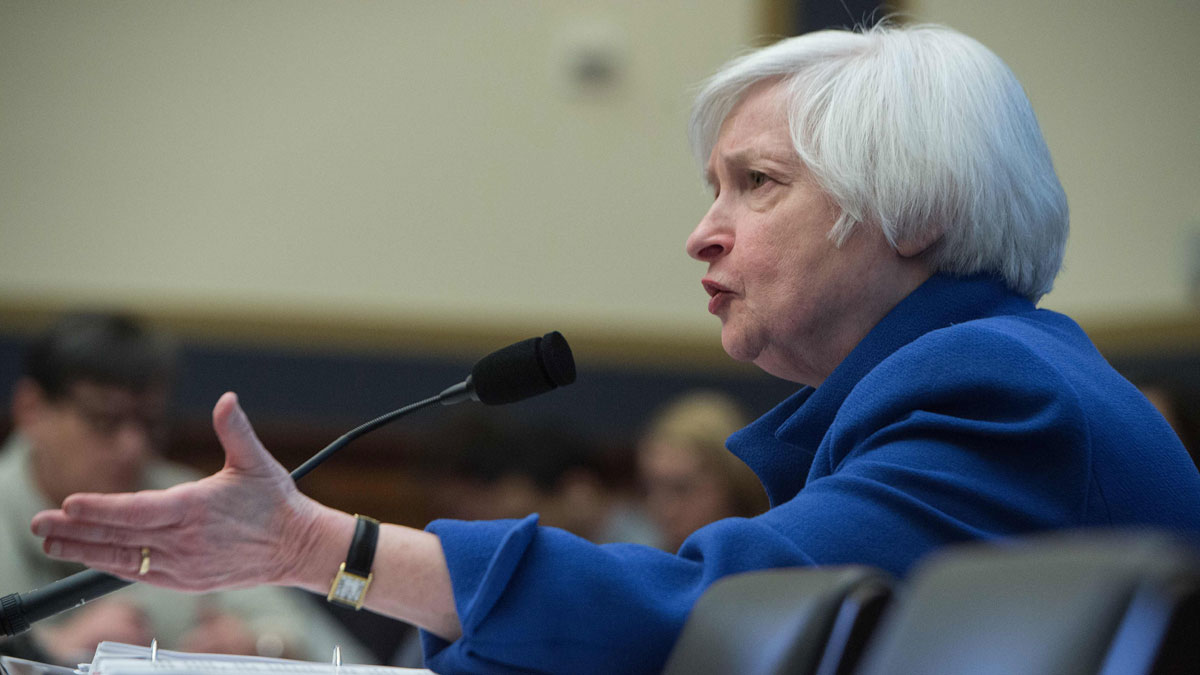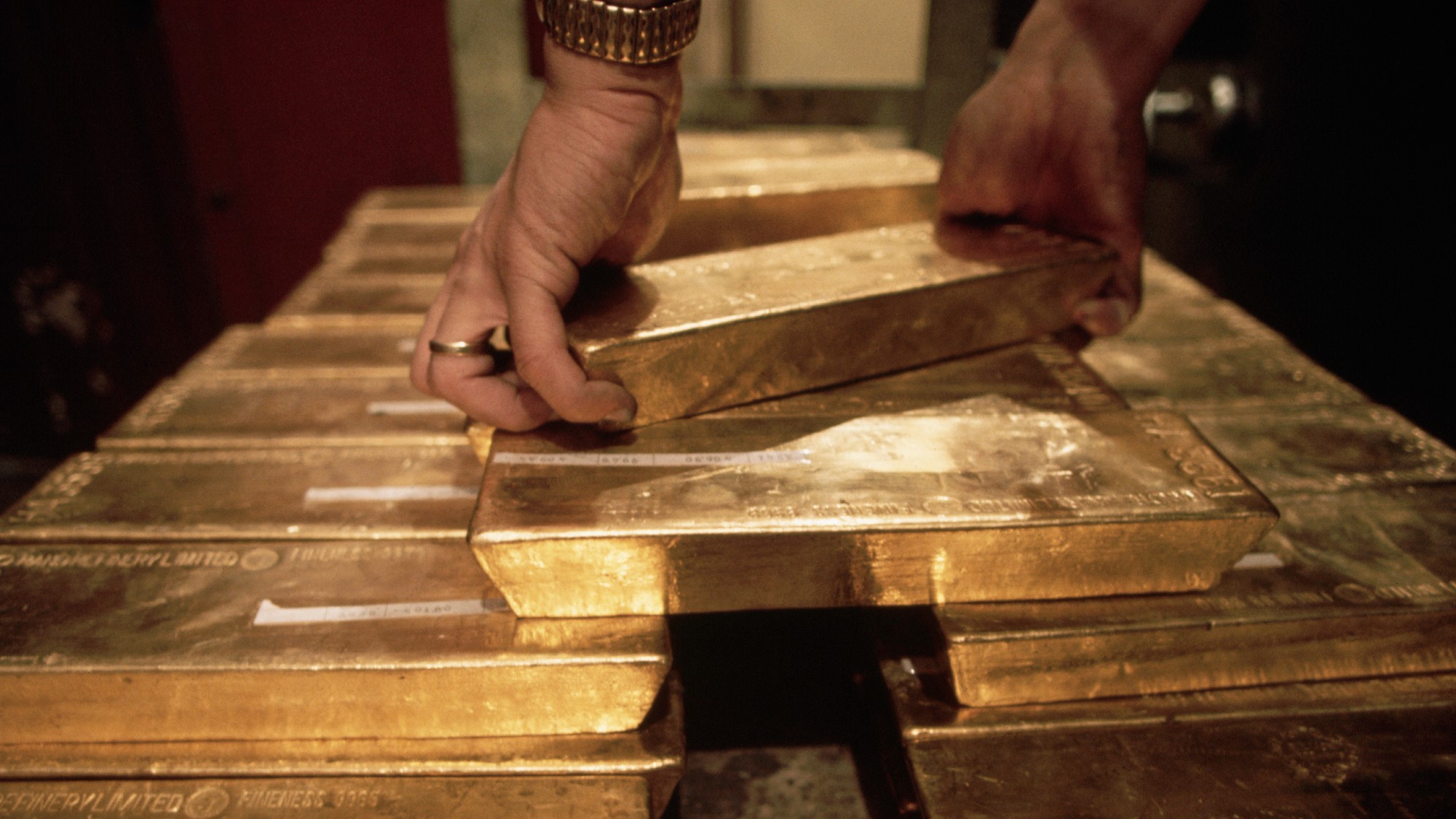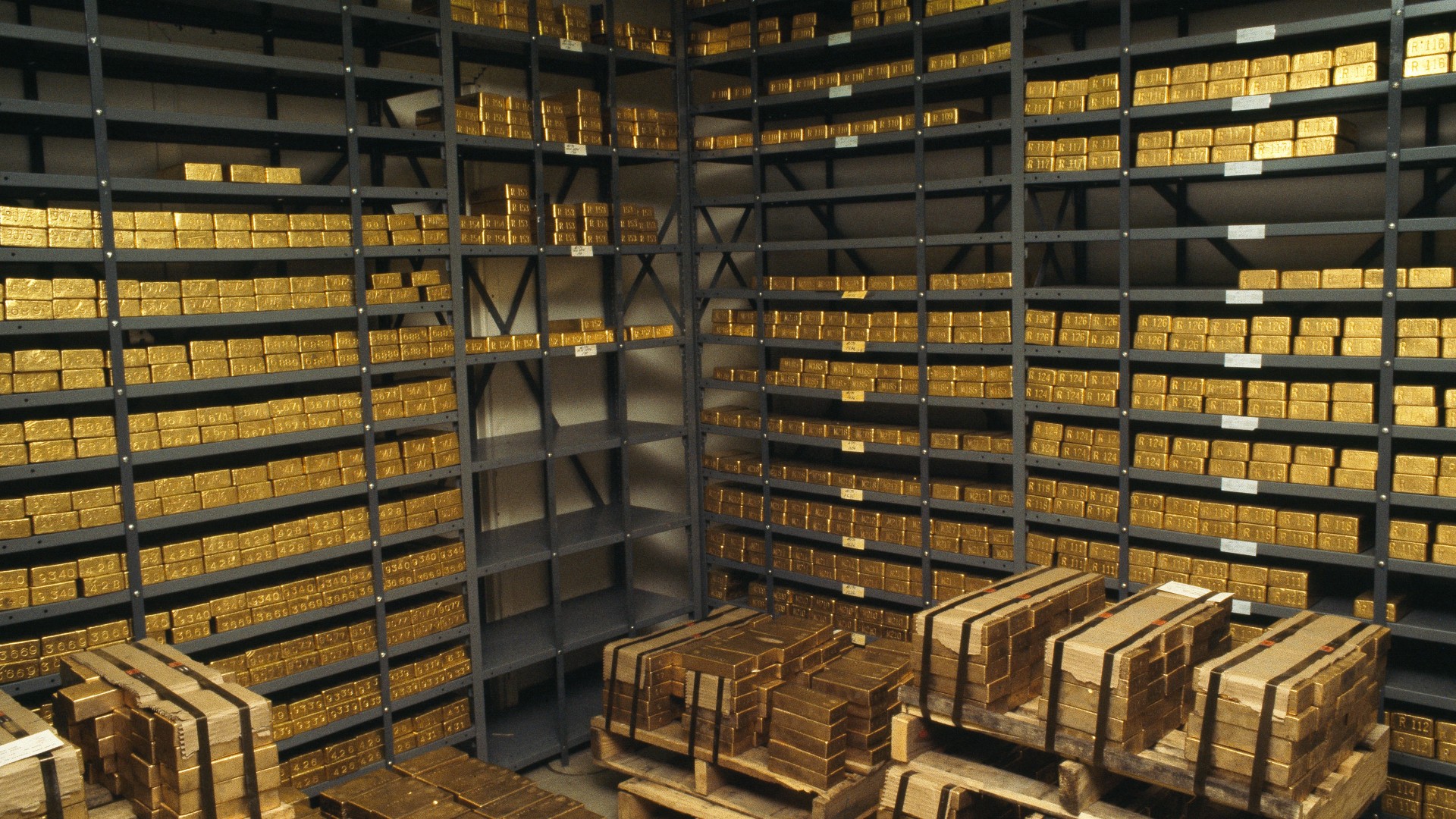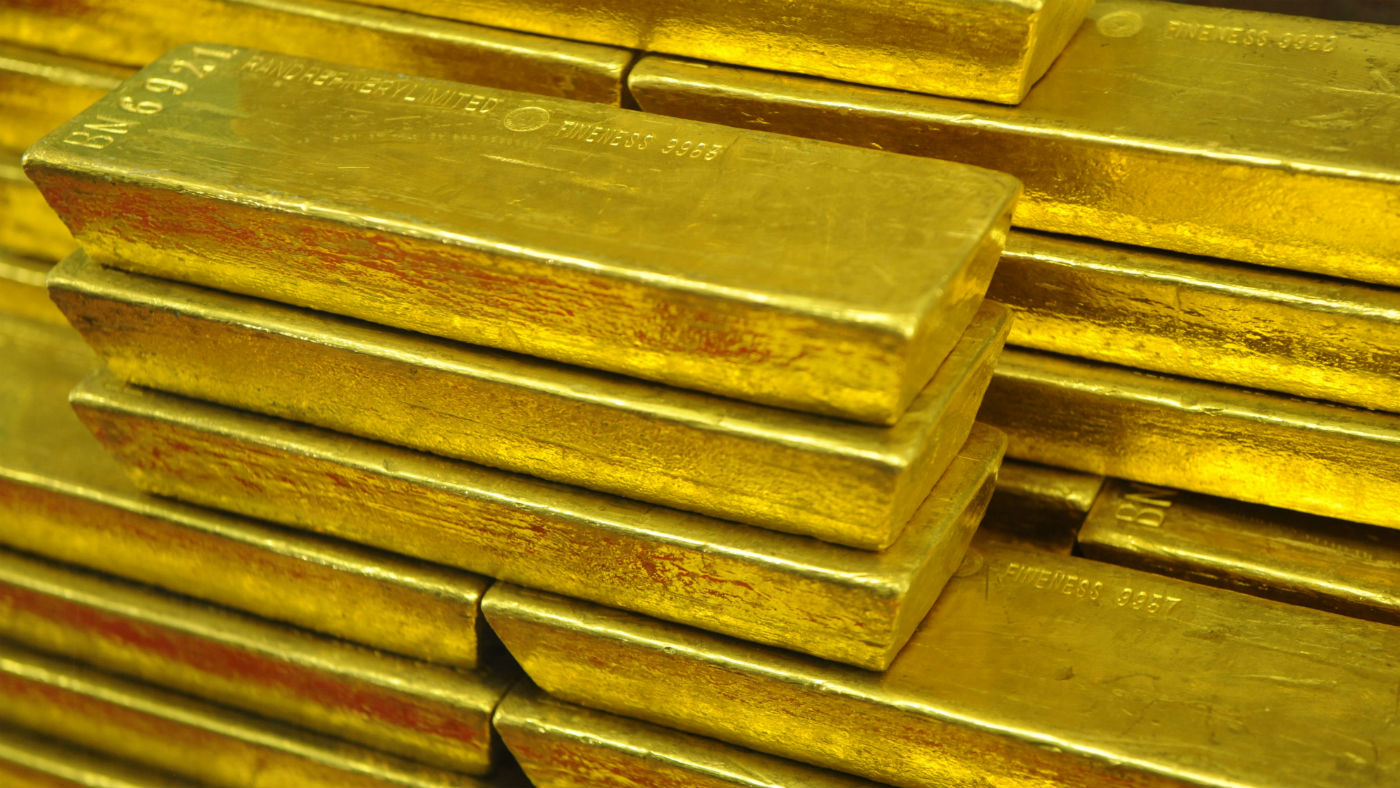Gold price waits for rates clues from Jackson Hole
Political turmoil in the US has the potential to 'help gold in the short and longer term'

Gold price finds 'no help' after downbeat forecasts
4 September
Gold found "no help" on Thursday as a spate of economic data from Europe and the US reduced inflation expectations. This sent the dollar higher, weighing down on the value of a precious metal that is often treated as a proxy currency and typically moves in the opposite direction to the greenback.
Market sentiment was driven in the main by the latest forecasts from the European Central Bank, which Reuters notes lowered its forecasts for inflation and growth over the coming three years amid "a slowdown in emerging markets and weaker oil prices". As "a traditional hedge against inflation, gold suffered from the downward revision", especially as the euro plummeted relative to the dollar.
The Week
Escape your echo chamber. Get the facts behind the news, plus analysis from multiple perspectives.

Sign up for The Week's Free Newsletters
From our morning news briefing to a weekly Good News Newsletter, get the best of The Week delivered directly to your inbox.
From our morning news briefing to a weekly Good News Newsletter, get the best of The Week delivered directly to your inbox.
Traders were also busy digesting a slight increase in US unemployment (although at a level still considered healthy), estimates of an ongoing weak wage growth and a downgrade in the economic growth forecasts in the UK. "No help for gold today: jobless claims, ECB hold(ing) rates unchanged, gains in stocks and wages show(ing) no inflation," RBC Wealth Management adviser George Gero wrote.
The metal fell around 1.1 per cent to a session low of $1,121 an ounce on the Comex exchange in New York and eventually settled at $1,123. Traders were also broadly bearish on the short-term outlook ahead of the release of critical US employment report today, which if positive could presage an increase in interest rates that would weigh on non-yielding gold.ScotiaMocatta analysts said the technical picture pointed to a further decline with "near-term support at $1,117", adding that they were bearish on the metal "so long as it trades below the recent high of $1,170".
A note from the dealing desk at Swiss refining and finance group MKS, reported by BullionVault, says that this Friday $1,125 would be an "important" support threshold for gold "if it is to break higher to test $1150."
Gold price heads lower after strong US data
03 September
A free daily email with the biggest news stories of the day – and the best features from TheWeek.com
Gold has been struggling to gain from equities volatility in recent weeks, but it reverted to its inverse correlation with wider markets on Wednesday as spot prices recorded the sharpest fall in a week.
Bloomberg reports that spot prices on the Comex exchange in New York fell 0.5 per cent, the biggest drop since 26 August, while the amount of money held in gold-backed exchange-traded funds fell by the most since July. Gold is currently trading at $1,133 an ounce, still three per cent off a high reached two weeks ago.
The latest fall was precipitated by employment data in the US, which showed that the economy added 190,000 jobs in July. This is more than the 177,000 added in June and paints a picture of relative health, despite the final number coming in below estimates around the 200,000 mark. The figures added to "speculation that the Federal Reserve is getting closer to raising interest rates".
Speaking to the Wall Street Journal, John Payne, senior market analyst with Daniels Trading in Chicago, said there remains a "lack of enthusiasm" for gold. This could persist for the foreseeable future as, whenever it finally happens, an interest rate rise that would knock the appeal of non-yielding commodities is coming down the line.
Some, however, suggest the troubles in China could worsen and that this could reignite the metal's appeal as a safe haven. This can go both ways – as the Journal notes China "accounts for almost a quarter of global gold demand" and devaluation and a decline in consumer prosperity could hit consumption.
Gold price: fall forecast as 'safe haven' status withers
02 September
Gold futures have settled at their highest level for more than two weeks on the US Comex exchange, but with prices rooted in a very narrow range analysts predict that the price is set for a sizable fall in the coming months.
Marketwatch says the 0.6 per cent rise to a $1,139.80 close in New York made for the best finish since 24 August. In truth, however, spot gold prices have barely moved for several sessions and the $1,140 an ounce at which the metal is trading this morning is identical to where it was at the same time on Tuesday.
This is despite the continuing volatility on equity markets, a state of affairs that might have been expected to give a boost to a precious metal traditionally seen by investors as a 'safe haven'. Some analysts are now questioning gold's supposed allure and predicting that with interest rate rises looming in the not too distant future prices are likely to drop.
Barclays says that it expects the already weak demand for physical gold to remain depressed, arguing that the market has already largely factored in a likely rate rise delay.
"We see limited support from physical fundamentals, and further support from US rate expectations should also be limited, as the market is already pricing in a low probability of a September hike."
Another bank is even more bearish. ABN Amro said in a note, reported by Gulf News, that gold's "safe haven character" has been "overshadowed" and "reduced significantly" by "the arrival of gold products that opened the market to a wider public", such as cheap tradeable exchange-traded funds, which are used for "speculation purposes". The bank predicts prices will fall to $1,000 by the end of the year and even as low as $800 next year.
Some see such forecasts as overly pessimistic, especially as we head into the peak Indian wedding season (which typically boosts demand). But there is little support for a major upwards movement. Rolf Schneebeli, CEO of Gold Services AG, says prices of the precious metal should hover around $1,080 to $1,100 by the end of 2015.
Gold price edges up but mood could turn
01 September
Gold is marginally higher this morning but remains rooted within a narrow range. According to one analyst, the metal is vulnerable to a fresh wave of selling from funds poised to increase bearish bets.
Having risen slightly on the latest Asian market declines, which the Wall Street Journal claims have boosted gold's "safe haven appeal", gold continued its gradual positive trend in European trading and was up around $6 an ounce to $1,141. This is still around two per cent off a recent high reached a little over a week ago and, the Journal notes, below the symbolically important $1,150 support level at which rallies have run out of steam of late.
The Financial Times says the gains on Tuesday are the result of a weaker dollar and lower interest rates in the US, which are making non-yielding gold appear more attractive at a time of equity volatility. Traders are also still broadly betting against a US rates rise this month that would pile pressure on commodities and gold in particular.
Some suggest, though, that the mood is brittle and prices could be set for a renewed decline. Firstly there is the uncertainty over rates, with Federal Reserve vice-chairman Stanley Fischer leaving the door open to a rise at its meeting in a little more than a fortnight.
Secondly there are indications that gold's recent pick-up is the result not of a fundamental bet on further growth but on a repositioning by funds, which could shift back to a more negative stance quickly.
Mining.com reports that in a research note to clients Saxo Bank analyst Ole Hansen says a recent move to a "net long" position by hedge funds – effectively a bet on price rises – was "driven by another big clear-out of short positions" which "puts to rest… the belief that the rally was driven by safe haven demand". This also means short sellers have "fresh ammunition to pounce" as and when they suspect prices are about to turn back.
Gold price: latest slide exposes myth of equities 'refuge'
28 August
Gold is not behaving itself this week. Perceived as a traditional 'safe haven', the metal should have risen when equities tanked and traders sought refuge, and then dipped just as sharply when equities staged a recovery.
Instead, it fell during Monday's panicked sell-off, albeit not on the same scale as stocks – and after holding relatively steady it has started to par some of its losses this week as equities have rebounded. On Friday it is up 0.8 per cent to $1,132, still around 2.5 per cent off a high reached during last Friday but up from a low point this week of $1,117.
While its chart would show less extreme movements than the wild oscillations on broader markets, it has broadly tracked the same trend. Bloomberg notes that the correlation between gold and the volatility index, which measures turbulence in the equities market, is at its "highest level since October 2013". So what is going on?
Charlie Bilello, the director of research at Pension Partners, which manages around $200m in assets, said this is more normal that you might think. In fact, having studied the movements of gold relative to equity markets since 1976, he says the chances of gold acting as a refuge and being inversely correlated to equities is "as good as a coin flip".
"The notion that gold always rises when the equity market falls is false. When you have the extreme deleveraging environment, people tend to just flock to treasuries and then sell everything, including gold."
What does that mean in the short term for gold? Probably not a lot: most traders seem to suggest it is still in the thrall of US interest rate speculation, which is now delicately balanced. A revision to data showed a surge in US economic expansion in the second quarter, adding to expectations of a rise, after a week in which the stockmarket turmoil convinced many that rates should stay where they are.
Howie Lee, an investment analyst at Phillip Futures Pte in Singapore, told Bloomberg that the fact gold is "still holding above $1,100 suggests that the market is pricing in the probability that the September rate hike won't materialize. It could be a December hike," he said.
Gold price: is the rally 'over and done'?
27 August
Gold has recovered slightly after hitting a one-week low overnight as expectations of a US rate hike in September were lowered – but after a sharp decline some analysts are now saying the recent rally is "over".
As US stocks surged on the back of a huge injection of stimulus by Chinese authorities to support its ailing markets, the safe haven of gold lost out to a move by investors to take on more risk and touched a low of $1,117 an ounce at one point. This, Reuters notes, was its lowest level for a week and marked a 1.3 per cent decline for the day, the steepest fall since 20 July.
Gold is steady at $1,125 on Thursday morning in London, having recovered slightly after a Federal Reserve ratesetter admitted the case for a US interest rate rise in September is "less compelling… than it was a few weeks ago".
But while the precious metal is up around five per cent from the July slump's low point, it remains three per cent down for this week despite wild volatility in equities that would normally be expected to prompt a flight to safety. Business Spectator says the "lack of reaction" to weak equities has "puzzled" many market participants – and prompted one analyst to say the recent rally is "over and done".
David Govett, a precious metals analyst at Marex Spectron, said in a note to investors that gold's rebound is "over and done for the time being" and that he would now "look to sell rallies in gold above $US1,150 an ounce".
It is unlikely gold will see a sharp fall in the short term, most agree, but similarly ANZ bank investors have "ignored the metal's haven appeal" and are unlikely to propel it significantly higher. It could break out of a relatively narrow range as a rates rise comes into sharper focus, but at a time of intense anxiety on markets, prompting unpredictable policy reactions in China, nothing is certain.
Gold continues slide as markets rise - and fall
26 August
Sentiment on gold may have shifted back to bearish as the metal continues its recent retreat from a seven-week high reached at the end of last week – despite volatile trading on equity markets.
Gold was trading down 0.1 per cent on Wednesday morning in London to $1,136 an ounce, three per cent lower than the seven-week intraday high reached on Friday of $1,168. This is in spite of weakness across equity indices, with European markets all showing early one per cent declines after the US and China both finished volatile sessions lower.
Having recovered throughout most of August, as investors shunned risk in the wake of a collapse in confidence in China that culminated in the 'Black Monday' crash, gold has noticeably failed to take advantage of the latest bout of volatility. A modest fall on Monday was attributed to investors covering losses elsewhere, which continued on Tuesday as markets rebounded. But as markets fall back again, 'safe haven' gold is still in the red.
The Wall Street Journal speculates that the shift may be the result of an improving view of the US economy, with consumers making positive sounds on the labour market in a survey this week and homebuilding back on track after a decline earlier in the summer. This is driving a view that the US is, to a degree, insulated from Chinese woes and that an interest rate rise could still be imminent.
"As to be expected, the calming of fears has taken the edge off of gold," Peter Hug, global trading director at Kitco, is quoted as saying in a note to clients. However, he adds that "a major swoon in gold prices" is not likely in the short term as uncertainty over the recovery remains.
Gold price slips again as investors bet risk selloff 'overdone'
25 August
Gold may have escaped the worst of the punishment meted out to other commodities, but it is continuing to wilt despite a second day of falling prices on the Chinese equity markets.
Having hit a high of $1,168 on Friday morning, its highest level since before it fell sharply throughout July, the gold price has been on a steady, if modest, slide. On Tuesday it is trading down 0.5 per cent at $1,148, lending support to those who said last week it would fail to find support at higher levels.
But why is this traditional safe haven not shining at a time when markets are in turmoil? The Australian says Monday's fall in the gold price was a result of the dire situation elsewhere, as traders were forced to sell expensive gold positions to raise cash for 'margin calls' covering losses elsewhere in their portfolio. A trillion dollars was wiped off markets worldwide in a tempestuous session, The Times notes.
Gold's decline has continued, however, because the global malaise has not. While China has fallen by another 7.6 per cent, European indices have opened markedly higher and futures trading indicates US peers could follow suit. The Financial Times suggests that while the mood could yet turn sour, as it did in wider Asia overnight after early gains, traders are generally calmer and of the view there is value to be had after an "overdone" sell-off.
In particular, the paper notes that the S&P 500's 14-day relative strength index is sitting at 18.3, "well below the 30 level that is seen as the threshold to oversold territory", while measures of volatility are currently double their long-term average. The dollar is therefore up, and the gold price, which tends to move in the opposite direction to the greenback, is down.
Colin Cieszynski, chief market strategist at CMC Markets, told Marketwatch that gold's failure to rally in the wake of the wider falls on Monday is a sign that its upper limits "may have been reached for now".
Gold price loses its glitter amid latest China crash
24 August
Gold prices may have recovered in the past two weeks, with China's troubles sparking a renewed interest in a precious metal that's widely seen as a safe haven for investors, but as stock losses spread to world markets even gold has tipped into the red.
European indices all opened more than two per cent lower on Monday after Asian markets plunged overnight. The trigger was yet another collapse in China, where the Wall Street Journal reports the benchmark Shanghai Composite exchange shed 8.5 per cent to close at 3,210, "bringing its losses since its mid-June peak to nearly 38 per cent". The small-cap Shenzhen index closed down 7.7 per cent.
Commodities have also crashed, with the Financial Times noting that an aggregated Bloomberg exchange covering "everything from egg futures to natural gas" fell 1.2 per cent to "its lowest since 1999". The international benchmark Brent crude oil price has surpassed the $45 a barrel low reached in January and is heading even lower in early European trading.
Gold has displayed relative resilience, but unlike recent sessions, in which it has risen as wider equities and commodities have fallen, it is down 0.1 per cent this morning to $1,159, having earlier been around 0.6 per cent lower. The FT says the metal fell because investors were forced to sell "quality assets to raise much-needed cash to meet margin calls" – that is, to cover expected losses across their portfolios.
Where gold goes from here remains a matter of much debate. Reuters reports many analysts are expecting prices to rise above $1,200 in the coming months as a "currency war" sparked by Chinese devaluation drives investors to a metal often used as a proxy currency. The trade website Mining.com adds that major investors such as hedge funds have moved into a net 'long' position based on betting that prices will rise and this could help to propel an upward trend.
On the other hand, many believe the fundamental market position does not favour a gold surge, especially as the dollar remains strong ahead of a US interest rate rise which even the most dovish economists expect in the next year. Last week Citi lowered its forecast for the gold price this year to $1,140 from $1,180 per ounce, with a further fall in 2016 to $1,050.
Gold price: has metal reached a turning point?
21 August
Some analysts are claiming that the gold price is at a "turning point" that will see it reverse losses for the year and push higher, after it continued a recent strong rally and reached a six-week high in morning trading on Friday.
In early European trading in London, spot gold reached a high of $1,168 an ounce, according to the Financial Times, back to levels seen before it endured the largest monthly fall in two years, in July, and around eight per cent higher than its lowest closing price of about $1,080. It has eased back to $1,153, but this is still significantly above levels at which it was expected to face stiff 'resistance' from buyers.
Gold is benefiting from a flight from risk across global markets as concern mounts over slowing growth in China. Some believe it is now set for a prolonged surge as it retains its attraction as a currency hedge and safe haven, while others argue that recent waning demand and a capital withdrawal by investors leaves it vulnerable to a renewed slide, especially when US interest rates increase and boost yields on alternative assets.
Mining.com speculated that gold may be at a turning point as further rises will force hedge funds to unwind "short positions", which are effectively a bet on lower prices, fuelling the rally. Ross Norman of Sharps Pixley told the website that while we "don't yet have a bull market", it believes "a figure above $1,240 will certainly give many renewed confidence".
But Marketwatch cites several analysts who "aren't confident that the tide has fully turned". Naeem Aslam, chief market analyst at AvaTrade told the website that technical resistance around $1,160, such as was seen on Friday morning, would trigger "profit taking that could push gold prices lower".
"The tide has not turned for gold at all and we do not see this trend going for long unless the situation becomes completely out of control in China," he added.
-
 The Week Unwrapped: What’s the cost of PFAs?
The Week Unwrapped: What’s the cost of PFAs?Podcast Plus why is George Osborne joining OpenAI? And has universal basic income finally come of age?
-
 The week’s best photos
The week’s best photosIn Pictures A dervish dance off, a frosty forest, and more
-
 Mount Rainier is on its way down
Mount Rainier is on its way downUnder the radar Its peak elevation is approximately 20 feet lower than it once was
-
 What a rising gold price says about the global economy
What a rising gold price says about the global economyThe Explainer Institutions, central banks and speculators drive record surge amid ‘loss of trust’ in bond markets and US dollar
-
 Gold tops $4K per ounce, signaling financial unease
Gold tops $4K per ounce, signaling financial uneaseSpeed Read Investors are worried about President Donald Trump’s trade war
-
 Safe harbor: Gold rises as stocks sink
Safe harbor: Gold rises as stocks sinkfeature It's a golden age for goldbugs
-
 What rising gold prices can tell us about the economy in 2024
What rising gold prices can tell us about the economy in 2024The Explainer Market hits all-time high, boosted by a weakening US dollar and rising global tensions
-
 Gold’s ‘flash crash’: what the experts think
Gold’s ‘flash crash’: what the experts thinkfeature Bad news, good news and a loss of faith
-
 What is the price of gold and when is best to buy?
What is the price of gold and when is best to buy?Speed Read Economic and geopolitical uncertainty traditionally drives investors to reliable metal markets